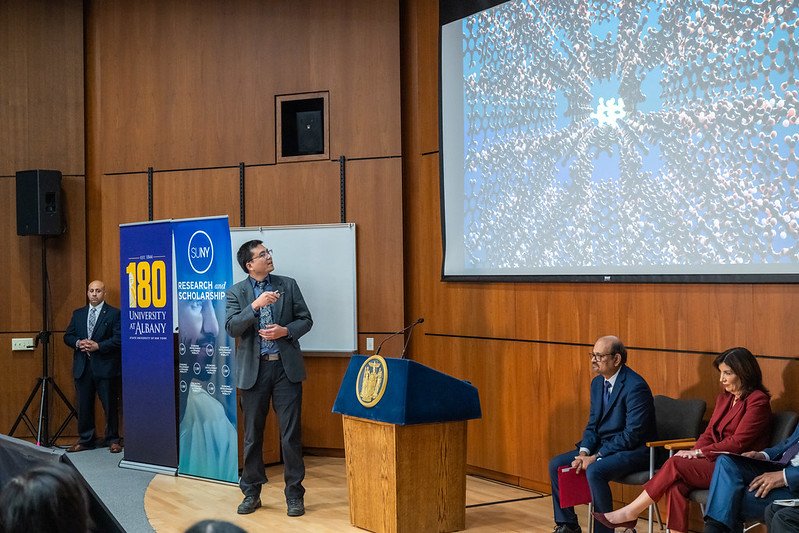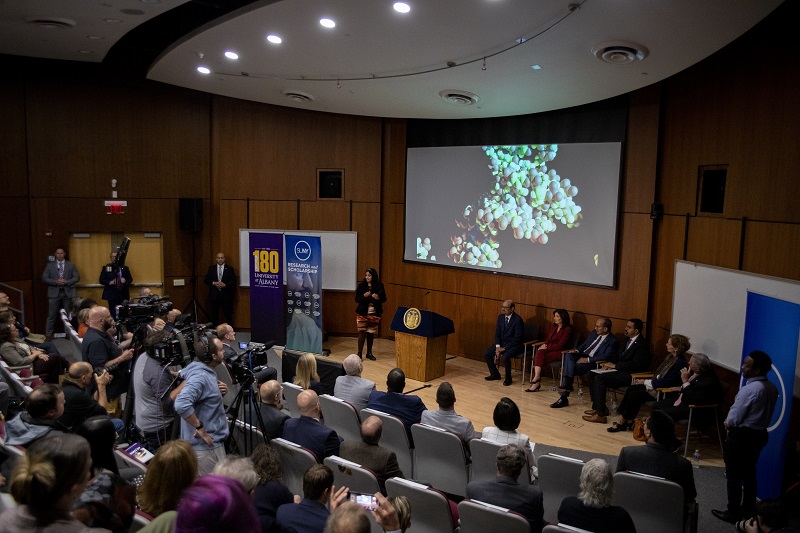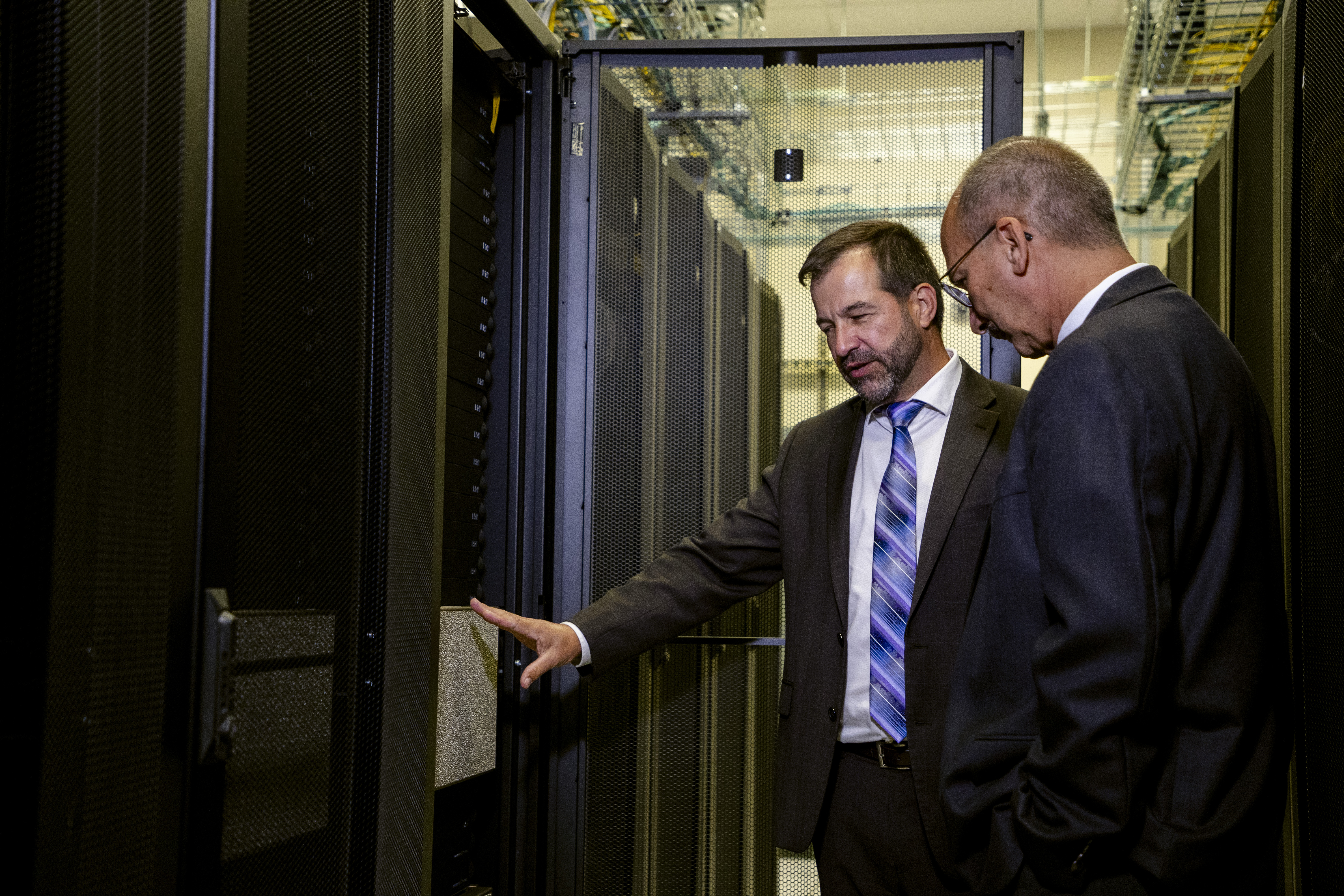UAlbany Unveils Powerful New AI Supercomputer
ALBANY, N.Y. (Oct. 10, 2024) — The University at Albany today unveiled one of the most advanced AI supercomputers at a U.S. university as officials celebrated a major leap forward in New York’s access to the world-changing technology.
Gov. Kathy Hochul and SUNY Chancellor John B. King Jr. joined UAlbany President Havidán Rodríguez for the announcement at UAlbany's RNA Institute, one of the research centers where scientists will use the powerful new system to hunt for treatments to devastating diseases.
[Read Gov. Hochul's press release and watch video of the announcement.]
The new $16.5M supercomputer, powered by NVIDIA DGX systems, is currently the most capable AI supercomputer within SUNY and a central pillar of UAlbany’s AI Plus initiative — a holistic push to integrate teaching and learning about AI across every college, school and major to ensure every graduate is prepared to live and work in a world radically changed by technology.
“This new AI supercomputer is a major step forward for the University at Albany — for our faculty, for our staff, for our researchers and especially for our students,” Rodríguez said. “UAlbany has been recognized as a national leader for our thoughtful and holistic approach to integrating AI into our teaching and research, and this new AI supercomputer is the next critical evolution of that strategy.
“Even more important than the technology is how we intend to use it — to help people,” Rodríguez said. “At UAlbany, we are focused on using AI for public impact research. Our researchers will use this AI supercomputer to advance research in fields as varied as atmospheric science and climate science, public health, RNA and nanotechnology to help build communities that are more resilient, healthier and equitable. That’s research that impacts the public good, that’s the true value of the technology, and that’s where UAlbany shines.”
A Preview of Empire AI
UAlbany’s new AI system also represents an important preview of what’s to come under Gov. Kathy Hochul’s $400 million Empire AI initiative, an ambitious public-private consortium dedicated to making New York a leader in AI technology.
SUNY is a central partner in the Empire AI consortium, which will fund the construction of a new AI supercomputer in Buffalo. UAlbany’s system also will provide SUNY campuses critical access to advanced AI computing.
UAlbany’s AI Plus Initiative took shape in February 2022, nine months before ChatGPT entered the public consciousness and the ubiquity of AI became a near-daily topic of news coverage.
Vice President for Research and Economic Development Thenkurussi (Kesh) Kesavadas had just arrived at UAlbany and quickly realized that researchers were eager for the computational muscle needed to take their work to the next level.
“The capacity of our faculty to do the kind of research they wanted was limited by the computing power they had,” Kesavadas said. “For us to hit real-world problems, we needed to invest in computing that is comparable to what is available in the private sector. So we decided to build a computing system that is second to none in New York and, most importantly, that will give our faculty the power to think big and solve real-world problems.”
In April 2022, Gov. Hochul and the state Legislature awarded $75 million to UAlbany — half of which would go toward completing the University’s new downtown engineering building, now known as CNSE Downtown, and the other half toward expanding UAlbany’s AI supercomputing capacity.
Soon after, UAlbany invested another stream of state funding in the largest cluster hire in its history — a search for 27 new faculty across all nine schools and colleges that made good on the promise that AI Plus would be a holistic, university-wide approach. Together with UAlbany’s many existing AI experts, those faculty form the core of UAlbany’s new AI Plus Institute, which promotes foundational and use-case AI research and helps bring AI specialists together to address AI-related problems and questions.
Last month, UAlbany appointed Prabha (Balakrishnan) Prabhakaran, a noted AI scholar from the University of Texas at Dallas, as the Institute’s first permanent director.
“Corporations are pushing the boundaries of AI with their investments, but the scope is typically limited to something that can produce revenue,” Kesavadas said. “Often, problems that actually need attention don’t make it to the top of the priority list unless industry sees that it’s going to lead to a market in the future. But as a public university we have the responsibility and interest to take those challenges on.”
During Thursday's unveiling, Associate Professor Alan Chen of the Department of Chemistry and RNA Institute Research Scientist Sweta Vangaveti demonstrated how researchers can use the supercomputer to test new structures and combinations to develop treatments for Myotonic Dystrophy, anti-viral drugs for COVID-19 or filter toxic PFAS chemicals out of water.
‘Dramatically Different’ — What Makes a Computer an AI Supercomputer?
Powered by 24 NVIDIA DGX systems, UAlbany’s new AI supercomputer is among the largest at a university in the United States. The systems— slotted in server cabinets in the University’s Data Center — contain 192 NVIDIA Tensor Core GPUs, networked with about three miles of fiber-optic cabling.
The accelerated computing power of GPUs makes them extraordinarily well suited for high-intensity AI tasks that require massive numbers of parallel calculations with large datasets to get answers quickly.
The interconnection of these powerful GPUs, and their collective capacity to complete large numbers of complex calculations quickly, is what makes them an effective research tool for applications like deep learning, a type of machine learning that can generate AI models for use cases like computer vision, cancer and tumor prediction and advance weather forecasting. Calculations that would have typically taken weeks on legacy systems can now be completed in days, and tasks that would have taken days can now be completed in hours.
“We’ve always had a high-performance computing cluster, but this is dramatically different,” said Brian Heaton, UAlbany’s chief information officer, whose staff in ITS helped design and build the system. “It’s the GPUs that make a supercomputer an AI supercomputer, and our new AI system is engineered for performance.”
“AI calls for intense mathematical computations,” Heaton said. “Your average computer is not able to keep up the pace of those calculations in order to make it productive in a reasonable time frame. A researcher developing AI can’t wait weeks and weeks for the results to come back. The more horsepower we can give our researchers and our faculty, the faster response times they get and the more productive they’ll be in the AI space.”
Hardware Is Only Half the Story
The University isn’t just investing in cutting-edge hardware. In addition to hiring 27 new faculty specializing in AI — the largest cluster hire in the University’s history — UAlbany has brought on new ITS and research support staff to assist faculty researchers in getting the most out of the new AI system.
These new hires were supported by new SUNY funding dedicated to expanding the University’s research portfolio and include infrastructure automation engineers and data storage engineers, who manage and maintain the system; research technology analysts who will work directly with faculty new to AI computing; and AI developer analysts to work with faculty who need advanced assistance.
“We needed to build a system that will allow any researcher at any level to come in and use it without stumbling over technical issues,” Heaton said. “But on the flip side, there are many researchers that have been doing AI for years and need command line access to the system. We’re accommodating the full range.”
AI Plus Academics
At the heart of the AI Plus model is a new three-tiered progression of coursework available to every student in every major. This progression carries students from a general understanding of foundational principles of AI to a discipline-specific focus on AI in their chosen field, such as the School of Social Welfare’s new Artificial Intelligence and Social Justice course.
These new offerings, such as the new graduate certificate in Data Science for Public Affairs in Rockefeller College of Public Affairs & Policy, come in addition to more traditionally STEM-focused programs like the new AI concentration in the College of Nanotechnology, Science, and Engineering’s MS in computer science, or the College of Emergency Preparedness, Homeland Security and Cybersecurity’s new undergraduate machine learning and game design minors.
Another new AI-related major awaiting approval by the state is a collaboration between CEHC and the departments of Art & Art History and Music & Theatre.















